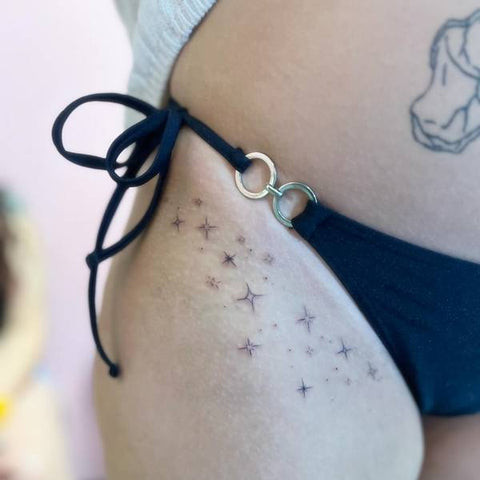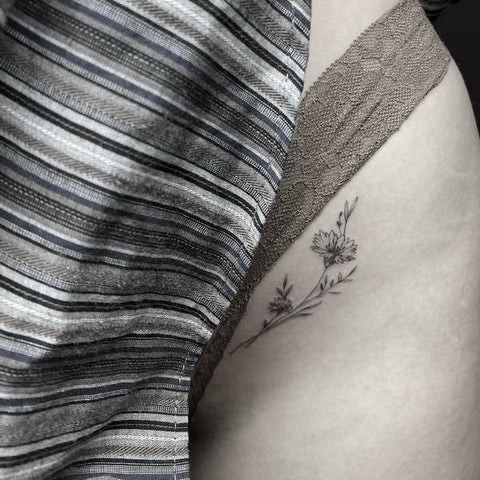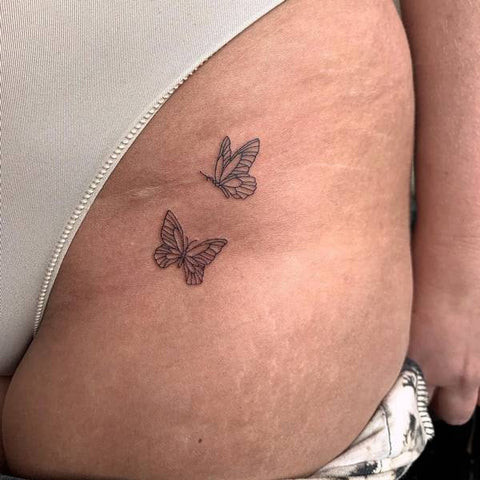A bikini line tattoo is a form of body art placed along the panty line, often chosen for its discreet placement and personal expression, and here at tattooat.com, we’re dedicated to helping you explore the world of tattoo art, from design inspiration to finding the perfect artist. Whether you’re seeking edgy ink, fashionable body art, or unique tattoo designs, a bikini line tattoo offers a blend of sensuality and self-expression. This guide will help you navigate the intricacies of bikini line tattoos, covering design ideas, pain considerations, aftercare tips, and more.
1. Understanding Bikini Line Tattoos
What exactly constitutes a bikini line tattoo? Let’s dive into the details.
A bikini line tattoo is a tattoo strategically placed along the area where underwear or a bikini bottom typically sits. These tattoos are usually small and discreet, designed to be partially or fully concealed, depending on the wearer’s choice of clothing. The appeal lies in its subtle yet personal nature, allowing individuals to express themselves in a unique and intimate way.
1.1. Popularity and Trends
Bikini line tattoos have surged in popularity in recent years, driven by trends in body positivity and personal expression. Celebrities and influencers often sport these tattoos, further fueling their demand. Common trends include minimalist designs, floral patterns, and symbolic imagery that resonate with personal stories and beliefs.
1.2. Why Choose A Bikini Line Tattoo?
There are several compelling reasons to opt for a bikini line tattoo:
- Discretion: The location allows for easy concealment, making it suitable for those who prefer a more private tattoo.
- Personal Expression: Despite its discreetness, it offers a way to express individuality and personal beliefs.
- Aesthetic Appeal: When done well, a bikini line tattoo can enhance the wearer’s sensuality and confidence.
- Small and Manageable: The limited space often necessitates smaller designs, which can be less intimidating for first-timers.
2. Design Ideas for Bikini Line Tattoos
The possibilities are endless when it comes to design. Here are some popular and creative ideas to consider.
2.1. Minimalist Designs
Minimalist tattoos are all about simplicity and elegance. These designs often feature clean lines and basic shapes, making them timeless and understated.
- Geometric Shapes: Triangles, circles, and squares can be arranged in unique patterns.
- Single Line Art: A continuous line forming a recognizable image, such as a flower or animal.
- Tiny Symbols: Small hearts, stars, or astrological signs can add a personal touch.
 Minimalist Star Bikini Line Tattoo
Minimalist Star Bikini Line Tattoo
2.2. Floral and Botanical Motifs
Floral tattoos are classic and feminine, lending themselves beautifully to the curves of the bikini line.
- Roses: Symbolize love, passion, and beauty.
- Lilies: Represent purity, renewal, and hope.
- Cherry Blossoms: Signify the beauty and transience of life.
 Bikini Line Floral Tattoo 1
Bikini Line Floral Tattoo 1
2.3. Animal and Insect Tattoos
Animals and insects can carry significant symbolic meanings, making them a popular choice for tattoos.
- Butterflies: Represent transformation, beauty, and freedom.
- Bees: Symbolize hard work, community, and dedication.
- Snakes: Signify rebirth, healing, and transformation.
 Bikini Line Butterfly Tattoo
Bikini Line Butterfly Tattoo
2.4. Abstract and Geometric Patterns
For those seeking a more modern and artistic design, abstract and geometric patterns can be a great choice.
- Mandalas: Represent the universe and spiritual journey.
- Tribal Patterns: Inspired by indigenous cultures, often symbolizing strength and heritage.
- Watercolor Designs: Soft, flowing colors that mimic the look of watercolor paintings.
2.5. Lettering and Quotes
Meaningful words and quotes can add a deeply personal touch to a bikini line tattoo.
- Initials: Representing loved ones or oneself.
- Short Quotes: Inspirational or motivational phrases.
- Significant Dates: Anniversaries, birthdays, or other important milestones.
3. Pain and Placement Considerations
One of the most common concerns when considering a bikini line tattoo is the level of pain involved and the optimal placement for the design.
3.1. Pain Levels
The bikini line area is known to be more sensitive due to the presence of nerve endings and thin skin. The pain level can vary from person to person, but it’s generally considered to be moderate to high.
- Factors Influencing Pain: Skin sensitivity, pain tolerance, the size and complexity of the tattoo, and the artist’s technique.
- Managing Pain: Using numbing creams, taking over-the-counter pain relievers, and choosing an experienced artist who can work efficiently.
3.2. Optimal Placement
The placement of the tattoo can affect both its aesthetic appeal and the level of discomfort experienced.
- Front of the Hip: Less sensitive area, ideal for larger designs.
- Along the Panty Line: Classic placement, suitable for small to medium designs.
- Lower Abdomen: Can be more painful but allows for larger, more intricate designs.
- Inner Thigh: Another option for discreet placement, with varying levels of sensitivity.
3.3. Consultation with Your Tattoo Artist
It’s crucial to have a thorough consultation with your tattoo artist before getting inked. They can provide valuable insights into pain management, design placement, and aftercare based on their experience.
4. Finding the Right Tattoo Artist
Choosing a skilled and reputable tattoo artist is paramount to ensuring a successful and safe tattoo experience.
4.1. Research and Reviews
Start by researching local tattoo studios and artists. Read online reviews and check out their portfolios to gauge their style and expertise. Look for artists who specialize in fine line work or the specific style you desire.
4.2. Portfolio Evaluation
A strong portfolio is a testament to an artist’s skill and experience. Look for consistent line work, clean shading, and overall attention to detail. Pay attention to tattoos in similar styles to what you’re considering.
4.3. Studio Hygiene and Safety
Ensure the tattoo studio adheres to strict hygiene and safety standards. The studio should be clean and well-maintained, with sterilized equipment and disposable needles.
4.4. Communication and Comfort
Choose an artist with whom you feel comfortable and can communicate openly. They should be willing to listen to your ideas, offer suggestions, and address any concerns you may have.
5. Preparing for Your Tattoo Appointment
Proper preparation can significantly impact your tattoo experience and the healing process.
5.1. Pre-Appointment Checklist
- Stay Hydrated: Drink plenty of water in the days leading up to your appointment to keep your skin hydrated.
- Avoid Alcohol and Blood Thinners: Refrain from alcohol and medications that thin the blood for at least 24 hours before your appointment.
- Shave the Area: Shave the bikini line area the day before to ensure a smooth surface for tattooing.
- Wear Comfortable Clothing: Opt for loose-fitting clothing that won’t irritate the tattooed area.
- Eat a Meal: Have a substantial meal before your appointment to keep your blood sugar levels stable.
5.2. What to Expect During the Appointment
Your tattoo artist will start by cleaning and sanitizing the area. They will then apply a stencil of your chosen design and begin the tattooing process. Be prepared to sit still for an extended period, and communicate any discomfort or concerns to your artist.
6. Aftercare and Healing
Proper aftercare is crucial for preventing infection and ensuring your tattoo heals properly.
6.1. Immediate Aftercare
- Keep it Clean: Gently wash the tattooed area with mild soap and water 2-3 times a day.
- Apply Ointment: Apply a thin layer of tattoo-specific ointment or fragrance-free moisturizer.
- Avoid Sun Exposure: Keep the tattoo out of direct sunlight, as UV rays can damage the ink and slow down healing.
6.2. Long-Term Care
- Moisturize Regularly: Keep the tattooed area moisturized to prevent dryness and itching.
- Protect from Sun: Use sunscreen with a high SPF to protect your tattoo from sun damage.
- Avoid Harsh Chemicals: Avoid using harsh soaps, lotions, or exfoliants on the tattooed area.
6.3. Potential Complications
While rare, complications can occur during the healing process.
- Infection: Redness, swelling, pus, or fever are signs of infection. Seek medical attention immediately.
- Allergic Reactions: Itching, rash, or hives may indicate an allergic reaction to the ink.
- Scarring: Can occur if the tattoo is not properly cared for or if the skin is prone to scarring.
7. Bikini Line Tattoo Removal
Despite careful planning, sometimes individuals may wish to remove their bikini line tattoo.
7.1. Laser Tattoo Removal
The most common and effective method for tattoo removal is laser treatment. The laser breaks down the ink particles, which are then naturally eliminated by the body.
- Process: Multiple sessions are typically required, spaced several weeks apart.
- Pain: The sensation is often described as similar to a rubber band snapping against the skin.
- Cost: Varies depending on the size and color of the tattoo.
7.2. Other Removal Methods
Other methods include surgical excision, dermabrasion, and chemical peels, but these are generally less effective and may result in scarring.
7.3. Considerations Before Removal
- Consultation: Discuss your removal options with a qualified dermatologist or tattoo removal specialist.
- Realistic Expectations: Tattoo removal can be a lengthy and expensive process, and complete removal may not always be possible.
8. Cultural Significance
Tattoos have diverse cultural and historical significance across the globe.
8.1. Historical Context
Historically, tattoos have been used to signify social status, tribal affiliation, and spiritual beliefs. In some cultures, tattoos are seen as a rite of passage or a form of protection.
8.2. Modern Interpretations
In modern times, tattoos are often viewed as a form of self-expression and personal adornment. They can be used to commemorate important events, honor loved ones, or simply showcase one’s individuality.
8.3. Ethical Considerations
It’s important to be mindful of the cultural significance of certain tattoo designs and avoid appropriating symbols or imagery that may be sacred or offensive to certain groups.
9. Express Yourself at Tattooat.com
Finding the perfect bikini line tattoo is an exciting journey of self-discovery and artistic expression. Whether you’re drawn to minimalist designs, floral motifs, or bold geometric patterns, the key is to choose a design that resonates with your personal style and beliefs.
At Tattooat.com, we’re passionate about helping you explore the world of tattoos. Our website offers a wealth of resources, including design inspiration, artist directories, and informative articles to guide you through every step of the process.
9.1. Find Inspiration
Browse our extensive gallery of bikini line tattoo designs to spark your creativity and discover new ideas.
9.2. Connect with Talented Artists
Use our artist directory to find skilled and reputable tattoo artists in your area who can bring your vision to life.
9.3. Learn and Grow
Read our informative articles on tattoo aftercare, pain management, and cultural significance to deepen your understanding of the art form.
10. Frequently Asked Questions (FAQ)
Here are some frequently asked questions about bikini line tattoos:
10.1. How painful is a bikini line tattoo?
The pain level varies, but it’s generally considered moderate to high due to nerve endings and thin skin in the area.
10.2. How much does a bikini line tattoo cost?
The cost depends on the size, complexity, and artist’s rates, typically ranging from $80 to $500 or more.
10.3. How long does a bikini line tattoo take to heal?
Healing typically takes 2-4 weeks with proper aftercare.
10.4. Can I get a bikini line tattoo if I have sensitive skin?
Yes, but it’s important to choose an experienced artist and use hypoallergenic ink to minimize the risk of allergic reactions.
10.5. What are the best aftercare products for a bikini line tattoo?
Use mild, fragrance-free soap and tattoo-specific ointment or moisturizer.
10.6. How can I prevent my bikini line tattoo from fading?
Protect it from sun exposure by using sunscreen and avoiding harsh chemicals.
10.7. Can I remove a bikini line tattoo if I change my mind?
Yes, laser tattoo removal is an effective option.
10.8. Is it safe to get a tattoo during pregnancy?
It’s generally not recommended due to the risk of infection and potential harm to the fetus.
10.9. How do I choose the right design for my bikini line tattoo?
Consider your personal style, symbolic meanings, and consult with your tattoo artist for guidance.
10.10. What should I do if my bikini line tattoo gets infected?
Seek medical attention immediately for treatment.
A bikini line tattoo can be a beautiful and empowering form of self-expression. By carefully considering your design, placement, and artist, and by following proper aftercare procedures, you can ensure a positive and rewarding tattoo experience.
Ready to start your tattoo journey? Explore our website, tattooat.com, for inspiration, artist connections, and expert advice. Discover the perfect design, find a talented artist near you (Address: 1825 SW Broadway, Portland, OR 97201, United States. Phone: +1 (503) 725-3000), and let us help you bring your tattoo dreams to life. Whether it’s fashionable body art or unique tattoo designs, tattooat.com is your one-stop destination.
Showcase your individuality with a bikini line tattoo that speaks volumes. Connect with us and start your tattoo story today. Visit tattooat.com now for a wealth of resources, inspiration, and the best tattoo artists in the USA
